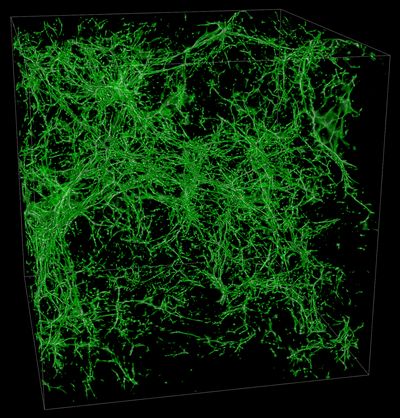ASTROPHYSICS
Mainstay Ensemble of Nyx HI Reionization Simulations
Principal Investigator:
Jose Oñorbe
Affiliation:
Universidad de Sevilla, Spain
Local Project ID:
CPRA100
HPC Platform used:
JUWELS of JSC
Date published:
By studying the distribution of galaxies it can easily be seen that below a certain scale the matter distribution of the Universe is not uniform, but rather it forms a vast network of filamentary structures known as the “cosmic web” (see figure). It is in the nodes and filaments of this cosmic web where galaxies and clusters of galaxies form. However, even today, most of the gas in the universe can be found in the spaces between these structures, also known as the intergalactic medium. The exact distribution of this gas and its temperature can tell us a lot about the laws that governed the expansion of our Universe and how the first stars and galaxies formed.
About 380,000 years after the Big Bang, primordial plasma recombined to form the first atoms, releasing the cosmic microwave background and initiating the cosmic ‘dark ages’. Afterwards the intergalactic medium gas expanded and cooled to very low temperatures (T~20 Kelvin), until the stars and/or black holes in primeval galaxies reionized and reheated the universe.
The gas in the intergalactic medium is very diffuse and therefore very hard to measure but it is not impossible with current state-of-the-art telescopes. In fact, there are multiple international observational efforts that are trying to measure and quantify this gas distribution using different observational techniques. In order to extract the maximum information from these observations, accurate predictions of the distribution and temperature of the gas for different models is needed. However, accurate simulations of the intergalactic medium are hard because of two size constrains: High spatial resolution is required to resolve the density structure of the intergalactic medium, while a relatively large box size is required to both capture the large-scale power and to obtain a fair sample of the universe. Ideally one will run coupled radiative transfer hydrodynamical simulations that include extra physics governing the radiative transfer hydrodynamical simulations which include extra physics governing the sources of ionizing photons (stars, quasars, etc.). Although significant progress has been made on this front, these simulations are still too costly and, in many cases, simple approximations are used in current methods for dealing with the radiation field.
A suite of cosmological hydrodynamical simulations with unprecedented dynamical range was performed on the supercomputer JUWELS of the Jülich Supercomputing Centre. The simulations have been performed with the Nyx code [1], a massively parallel grid hydrodynamics code specifically designed for this purpose. In addition to gravity and gas dynamics solvers, Nyx has a set of additional physics necessary to model the intergalactic medium. The code follows the abundance of six species: neutral and ionized hydrogen, neutral, once and twice ionized helium, and free electrons. For these species, all relevant atomic processes, ionization, recombination, and free-free transitions, are modeled in the code. Heating and cooling are calculated using a sub-cycled approach in order to avoid running the whole code on a short, cooling timescale and resulting source terms are included in energy equations using xtrang splitting.
A new approximate method to model inhomogeneous reionization developed by the PI [2] was also used in the simulations. The method allows to explore the full physical parameter space and provides accurate fits to observations at a cost dramatically less than using full radiative transfer simulations.
The datasets generated from these simulations will be crucial to inform many cosmological and astrophysical applications in the years to come, including different statistics of the Lyα and Lyβ forest, 21-cm modeling, and constraints on the nature of dark matter. For example, by directly comparing with observational data, these simulations will allow us to put direct constraints on when and how hydrogen reionization happened and which sources are responsible of it. Several students in different parts of the world are currently using these simulations to develop their Master and PhD projects.
References
[1] Nyx: a massively parrallel AMR code for computational cosmology. Ann S. Almgren, John B. Bell, Mike J. Lijewski, Zarija Lukić, and Ethan Van Andel. 2013. The Astrophysical Journal, Volume 765, Number 1
[2] Inhomogeneous reionization models in cosmological hydrodynamical simulations. Oñorbe, Jose; Davies, F. B.; Lukić, Z.; Hennawi, J. F.; Sorini, D. 2019. Monthly Notices of the Royal Astronomical Society, Volume 486, Issue 3, p.4075-4097
Scientific Contact
Jose Oñorbe
Facultad de Físicas
Universidad de Sevilla
Avda. Reina Mercedes s/n
Campus de Reina Mercedes
41012 Sevilla (Spain)
e-mail: jonorbe [@] us.es
http://www.joseonorbe.com/
NOTE: This project was made possible by the Partnership for Advanced Computing in Europe (PRACE) granting computing time on HPC system JUWELS of GCS centre Jülich Supercomputing Centre (JSC). GCS is a hosting member of PRACE.
JSC project ID: PRA100
February 2020
